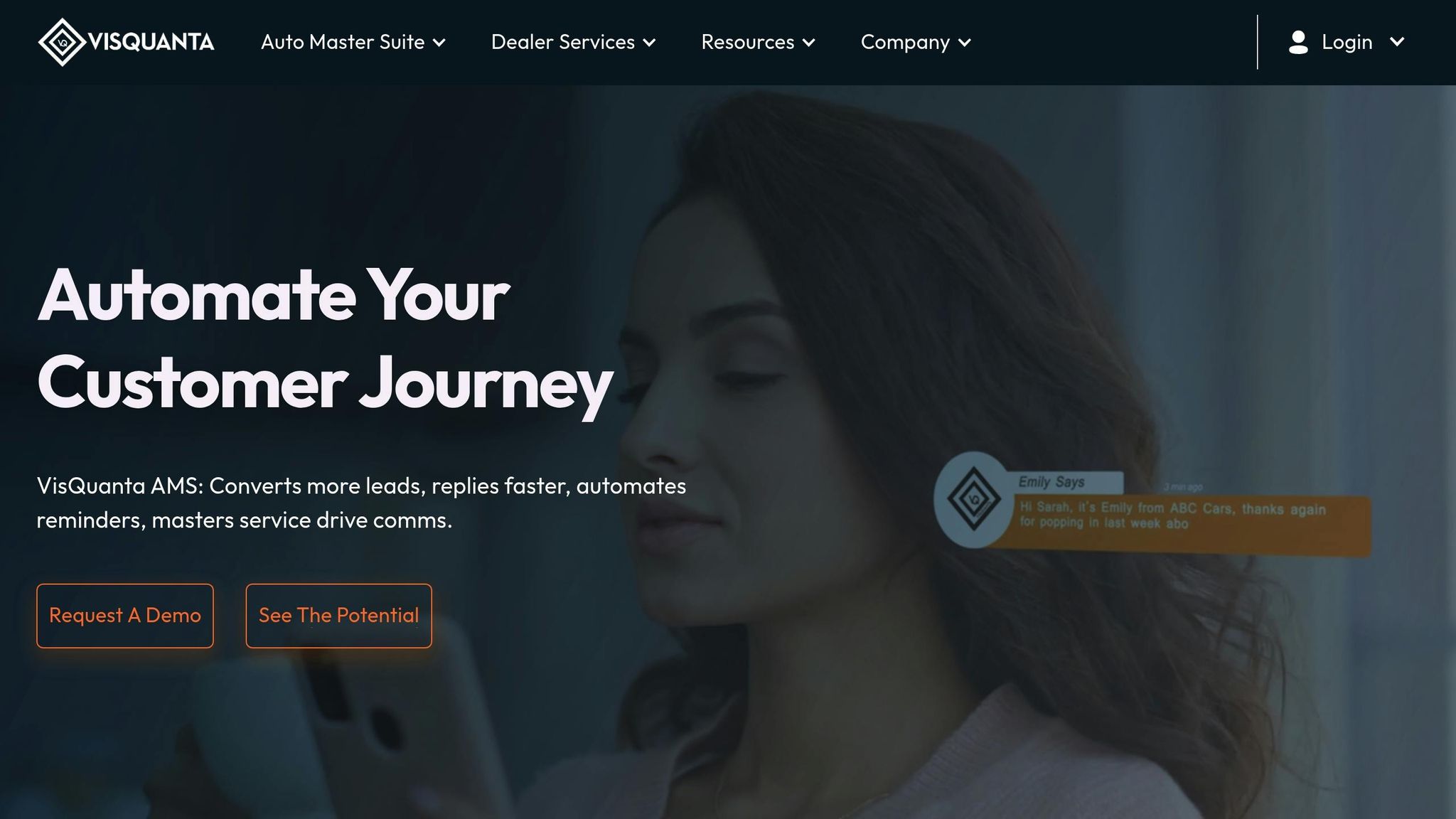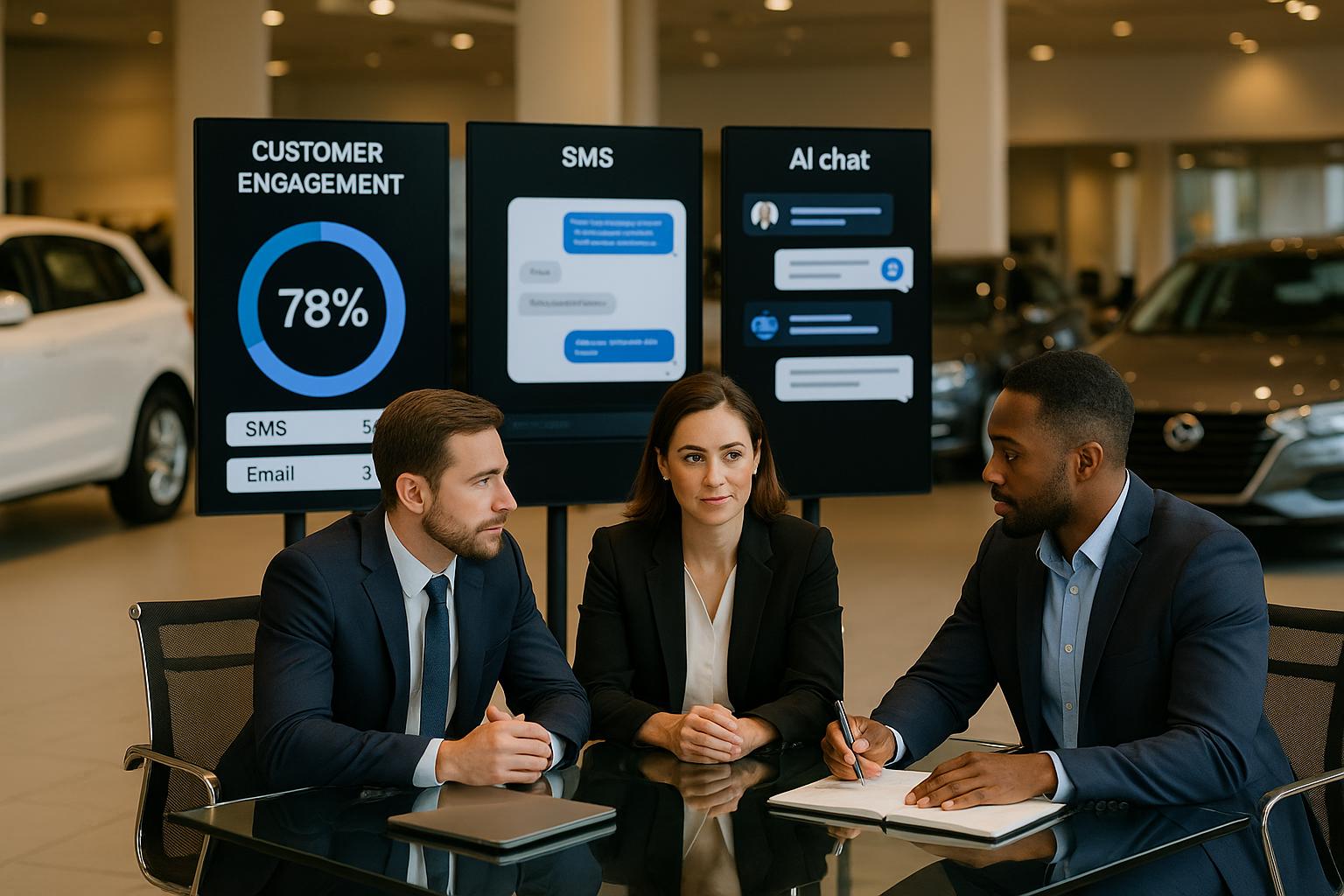The bottom line: To improve sales and customer engagement, dealerships must use SMS, email, and AI chatbots strategically. Each tool serves a specific purpose in the car-buying journey, and combining them can dramatically boost results.
- SMS: Ideal for quick, direct communication with a 98% open rate and 29% conversion rate. Best for appointment reminders, urgent updates, and follow-ups.
- Email: Perfect for sharing detailed information and nurturing leads over time. Offers a $42 ROI per $1 spent and works well for promotions, newsletters, and service reminders.
- AI Chatbots: Provide 24/7 availability and handle up to 90% of routine inquiries. Great for lead qualification, after-hours engagement, and initial customer interactions.
Quick takeaway: Integrating these tools with a CRM system is key. It ensures smooth communication, better lead tracking, and higher conversion rates. Dealerships that combine these channels see higher engagement and faster response times, delivering a better overall customer experience.
Using Built-in Text Messaging & Email Features
SMS: Fast Communication for Quick Responses
SMS is one of the quickest and most direct ways for car dealerships to communicate with customers. In an industry where timing can make or break a sale, text messaging offers the speed and efficiency needed to connect with buyers right when it matters most.
Why SMS Works for Dealerships
Text messages have an unmatched open rate - 98% of them are read, compared to just 15–20% of emails [7][8]. Even more impressive, 98% of texts are read within two minutes, often within seconds, while only 20% of emails are opened in the same window [6].
This high visibility translates into better results. SMS click-through rates hit 36% when a link is included, far surpassing email's 2.6% [7]. Conversion rates tell a similar story: SMS achieves a 29% conversion rate compared to email's 15.2% [7].
The financial upside is hard to ignore. Nearly 60% of marketers report that SMS marketing significantly boosts revenue, with some businesses generating up to $71 for every dollar spent [5].
SMS also provides a personal, non-intrusive way to engage customers, avoiding the frustration of disruptive calls or overlooked emails [6]. Whether it’s appointment confirmations or service updates, text messaging helps dealerships build trust and maintain strong relationships throughout the customer journey [3]. Plus, automation makes it easy to handle routine tasks like reminders and follow-ups [2][3].
With these advantages, SMS is a natural fit for time-sensitive dealership communications.
Best Uses for SMS in Dealerships
Timing is everything. Reaching out within five minutes of an inquiry can boost engagement 100-fold compared to waiting 30 minutes. Responding within one minute? That can lead to a staggering 391% increase in lead conversions [9].
SMS is perfect for tasks like appointment reminders, which cut down on costly no-shows [5]. It’s equally effective for test drive confirmations, service scheduling, and maintenance updates.
Post-sale and post-service follow-ups are another key opportunity. For example, Koons Automotive saw a 633% increase in new reviews and raised their Google star rating from 4.2 to 4.5 in just three months by using SMS for timely review requests [2]. Similarly, Bill Dickason Chevrolet sent only one or two highly relevant texts per month (15 texts over a year), converting over 17,000 customers into SMS subscribers with a retention rate above 90%, generating $231,000 in gross profit [4].
SMS also shines with targeted campaigns. Whether it’s service reminders, promotions for specific vehicles, or personalized offers, dealerships can use text messaging to engage customers in a way that feels both timely and relevant [3].
Navigating SMS Limitations and Legal Requirements
While SMS offers many advantages, it comes with strict legal guidelines. Compliance with the Telephone Consumer Protection Act (TCPA) and Cellular Telecommunications Industry Association (CTIA) standards is non-negotiable [10].
Dealerships must have express written consent before sending marketing texts [10][11]. Violating this rule can lead to TCPA fines ranging from $500 to $1,500 per message [10]. Additionally, the National Do Not Call Registry applies to SMS, with fines reaching up to $46,517 per violation [12].
To stay compliant, businesses must:
- Provide clear opt-out options, such as allowing recipients to reply "STOP."
- Be transparent about message types and frequency.
- Respect time restrictions, as the TCPA prohibits marketing texts between 8 AM and 9 PM in the recipient's time zone [11].
Other challenges include SMS's character limits, which require concise messaging, and the risk of annoying customers if overused. Since texts arrive on personal devices via regulated networks, their use must be thoughtful and strategic [13].
Smart dealerships mitigate risks by using double opt-in processes and keeping detailed records of customer permissions [10]. This cautious approach not only ensures compliance but also safeguards customer trust while maximizing the efficiency of SMS communication.
Email: Detailed Content for Lead Development and Customer Retention
Email marketing is a powerhouse for dealerships, delivering an impressive $42 return for every $1 spent [14]. Unlike the fast-paced nature of SMS, email shines when it comes to building meaningful, long-term relationships with customers through engaging and informative content.
Why Email Works for Dealerships
The real strength of email lies in its ability to deliver tailored content that nurtures leads over longer buying cycles. In the automotive world, where decisions often take weeks or even months, this steady approach can make a big difference.
- 50% of people make purchases directly from marketing emails [15].
- 59% of car buyers say dealer emails influenced their decision to visit a showroom [16].
- 23% of dealership website visits come from email links [16].
"Email marketing is one of the most effective and cost-efficient marketing tools out there for retailers in general, and car dealers in particular." – Ro Oranim, Fullpath
Email campaigns typically achieve 9–12% open rates and up to 14% click-through rates, while triggered messages - like automated follow-ups - perform even better, with 70.5% higher open rates and 152% higher click-through rates [16].
The ability to segment and target audiences is another major advantage. Automakers often use past purchase data and online behaviors to craft highly relevant campaigns [17]. For instance, Audi uses automated workflows to send personalized emails after a prospect submits an inquiry or downloads a brochure. These emails are carefully timed over several weeks to guide the customer through their buying journey [17].
Smart Ways Dealerships Use Email
Email is the perfect platform for rich, visual content. For example, Mercedes-Benz creates sleek, responsive designs featuring high-quality vehicle images [17].
It also works well for educational content. Toyota’s approach includes maintenance tips, road trip preparation guides, and exclusive webinar invites where potential buyers can learn about new models from experts [17]. This kind of content not only informs but also builds trust, positioning the dealership as a helpful resource.
When it comes to promotions, email delivers strong results - especially when campaigns are segmented. Honda, for instance, sends seasonal offers and financing deals to specific groups, like recent showroom visitors, ensuring the content stays relevant without overwhelming recipients [17].
Other high-impact strategies include:
- Service reminders: Emails sent 7–10 days before scheduled service see 41% open rates [16].
- Anniversary messages: Personalized emails tied to milestones achieve 45% open rates and often include exclusive offers.
- Trade-in campaigns: These perform best when sent 24–36 months into the ownership cycle, featuring tools like personalized equity calculations [16].
Lexus takes personalization to the next level by integrating AI into their email strategy. By analyzing demographics and online engagement patterns, they create hyper-tailored campaigns that have significantly boosted test drive bookings [18].
Challenges with Email Marketing
While email offers plenty of advantages, it’s not without its hurdles. To make the most of this tool, dealerships need to address several common issues.
Deliverability problems are a major concern. About one in six permission-based marketing emails never reaches the inbox, and platforms like Gmail and Yahoo Mail may block senders with spam complaint rates as low as 0.3% [19].
Another challenge is database decay. On average, customer email data deteriorates by 22.5% annually, and a survey found that 48% of dealership email lists contained outdated addresses [19]. This can hurt campaign performance and waste marketing dollars.
Lower engagement rates also pose a challenge, with average open rates in the automotive industry hovering around 9–12% [19]. Compounding this issue is the lack of mobile optimization, even though 81% of people prefer checking emails on their smartphones [20]. Poorly formatted emails can quickly turn off potential customers.
Finally, dealerships often struggle with content quality and CRM limitations. Generic messages lead to higher unsubscribe rates, while outdated CRM systems may lack the tools needed for bulk sends or advanced automation, limiting personalization and effectiveness [19].
Overcoming Email Challenges
To tackle these issues, dealerships are adopting smarter strategies:
- Data hygiene tools help update outdated contact information.
- Dedicated email platforms improve deliverability and support advanced features.
- Sunset policies remove disengaged subscribers after 6–9 months of inactivity [19][20].
Regular A/B testing and performance tracking can pinpoint what resonates with different audiences. Re-engagement campaigns are also useful for bringing inactive subscribers back into the fold.
When combined with SMS and AI chatbots, email remains a cornerstone of any dealership’s communication strategy, offering a reliable way to connect with customers and drive results.
AI Chatbots: Round-the-Clock Customer Service and Lead Screening
AI chatbots provide dealerships with a game-changing ability to offer 24/7 customer service, ensuring that the 30% of car research conducted after hours doesn’t go unanswered [22]. These modern tools can manage complex conversations and seamlessly qualify leads through CRM integration, paving the way for the detailed advantages outlined below.
Benefits of AI Chatbots for Dealerships
One of the standout benefits of AI chatbots is their ability to handle 90% of customer inquiries automatically [21]. By addressing questions about specifications, pricing, financing, and services, chatbots significantly reduce the workload for dealership staff.
The financial upside is hard to ignore. In 2024, 37% of dealerships using AI reported a 20–30% increase in revenue, and a striking 81% planned to increase their AI budgets in 2025 [23].
Chatbots also shine in lead qualification. They collect key details - such as budget, preferred models, fuel preferences, and financing needs - before passing qualified leads to the sales team. This process helps prioritize high-value prospects and ensures resources are allocated efficiently.
The results speak for themselves. For instance, Maruti Suzuki’s virtual sales avatar achieved a 33% increase in lead generation [25]. Its WhatsApp chatbot facilitated 10,000+ test drive bookings and 82,000 brochure downloads. Similarly, BYD’s WhatsApp chatbot handled over 60,000 customer interactions [25]. With CRM systems capturing all these interactions, sales teams are better equipped to engage with potential buyers.
When to Use AI Chatbots in Dealerships
AI chatbots excel in scenarios where immediate and consistent engagement is crucial. After-hours inquiries are a prime example, as 30% of car research takes place outside regular business hours [22].
They’re also highly effective for initial lead screening. When a visitor lands on a dealership’s website, chatbots can quickly engage them, asking about vehicle preferences, budget, and purchase timelines. This is especially important since nearly 25% of automotive leads go unanswered within 24 hours [23].
Chatbots can also reactivate dormant leads. By reaching out with personalized messages about new models, service promotions, or trade-in opportunities, they help re-engage past customers.
During high-traffic periods - such as promotional events, seasonal sales, or new model launches - chatbots efficiently manage the surge in inquiries, ensuring no potential customer is left waiting.
They streamline financing pre-qualification too, gathering necessary details and explaining financing options before connecting customers with finance managers. This simplifies the process and enhances the customer experience.
Follow-up communications are another area where chatbots shine. With 80% of sales requiring five or more follow-ups, yet many salespeople stopping after just two [26], chatbots can maintain consistent contact, improving conversion rates.
When paired with SMS and email, chatbots complement a multi-channel CRM strategy, ensuring prompt and effective engagement throughout the sales funnel.
AI Chatbot Limitations
Despite their many strengths, AI chatbots have some limitations that dealerships must navigate. For example, complex scenarios - like unique trade-ins or intricate financing issues - often require human involvement.
Chatbots also lack emotional intelligence. While they excel at answering factual questions, they can’t interpret emotional cues or provide the empathy needed in sensitive situations, such as when customers face financial stress.
Technical expertise is another consideration. Chatbots require regular updates to their knowledge base and conversation flows, and CRM integration often demands skilled professionals.
Clear escalation protocols are essential. Without them, unresolved issues can frustrate customers if the chatbot fails to transfer them seamlessly to a human team member.
Additionally, automotive chatbots must be tailored to the industry. They need to understand specific terminology, financing options, warranty details, and local regulations. Generic chatbot solutions may fall short of these specialized requirements.
Finally, customer preferences can pose challenges. Some buyers, particularly those making high-value purchases like vehicles, prefer a personal touch. Chatbots should be designed to enable quick and smooth handoffs to human staff when needed.
The key to success lies in balancing these limitations with the advantages chatbots offer. By integrating them into a broader digital strategy - handling routine tasks while leaving complex, relationship-driven interactions to human staff - dealerships can elevate customer service and optimize lead management.
Comparison: Selecting the Right Tool for Each Sales Stage
Choosing the right communication tool can make all the difference in converting leads. Each channel - SMS, email, and AI chatbots - has its strengths, and understanding where they shine helps you deploy them effectively across the sales funnel.
Direct Comparison of SMS, Email, and AI Chatbots
When it comes to engagement, SMS stands out with an impressive 98% open rate, far surpassing email’s 32% average [27]. AI chatbots, on the other hand, excel at providing instant, 24/7 responses, making them ideal for real-time interactions.
Looking at return on investment (ROI), SMS generates $71 in revenue for every dollar spent, while email delivers $36 per dollar [27]. However, the right choice depends on your specific sales stage and audience preferences.
| Feature | SMS | AI Chatbot | |
|---|---|---|---|
| Open Rate | 98% [27] | 32% (average) [27] | N/A (varies by implementation) |
| Response Time | Minutes [27] | Hours [28] | Instant |
| ROI | $71 per $1 spent [27] | $36 per $1 spent [27] | Depends on implementation |
| Best Sales Stage | Immediate follow-up, closing [27] | Lead nurturing, information sharing [27] | Initial engagement, qualification [24] |
| Best For | Appointment reminders, urgent updates, flash sales | Newsletters, detailed reports, complex information | Initial inquiries, lead qualification, 24/7 service |
| Personalization | Limited by character count [27] | Extensive [27] | High, based on data and AI |
| Unsubscribe Rate | Less than 5% [27] | Approximately 20% annually [27] | N/A |
SMS leads the pack in conversion rates, with click-through rates between 21–30%, and 62% of people read and respond to texts within minutes [27]. Meanwhile, email shines for sharing detailed information, such as newsletters or graphic-heavy promotions, thanks to its cost-effectiveness per message. AI chatbots are perfect for initial engagement, qualifying leads with targeted questions, and providing instant answers [24].
Using Multiple Channels Together
The real magic happens when businesses combine these tools strategically. Companies that use multiple communication channels see engagement rates soar by up to 250% and achieve 190% more frequent purchases [31]. For example, you could start with an AI chatbot on your website to capture interest, follow up with an email containing detailed product information, and close the loop with an SMS appointment reminder. This kind of sequence takes advantage of each channel’s strengths while ensuring consistent messaging.
Personalization plays a huge role in this strategy. Fast-growing companies generate 40% more revenue from personalization than their slower competitors [31]. AI tools make multi-channel coordination easier by centralizing data, automating tasks, and tailoring interactions. For instance, MeinAuto, a German online car retailer, increased leads by 10% by using a chatbot to guide customers through car selection and payment options. The chatbot qualified leads by asking targeted questions before handing them off to the sales team [24].
Consistency across channels is critical. While 79% of customers expect seamless interactions, 55% feel like they’re dealing with disconnected departments [31]. A CRM system bridges this gap, tracking customer interactions and ensuring smooth transitions between communication methods. This integrated approach also lays the groundwork for efficient CRM connectivity, which we’ll explore in the next section.
Important Factors for U.S. Dealerships
When implementing a multi-channel strategy, it’s essential to consider U.S. market-specific factors. For example, SMS marketing must comply with TCPA regulations, including opt-in requirements and timing restrictions.
Customer preferences also vary by generation. Millennials often prefer live chat and texting [30], while older customers lean toward phone calls and email. Building trust is another key factor - 91% of consumers say trust is essential when choosing a dealership [29].
The shift toward digital interactions has been rapid. In 2021, 72% of shoppers reported being satisfied with online shopping experiences, up from 60% in 2019. Additionally, 64% of consumers want more of the purchasing process to happen online [30]. Personalization is a big part of this trend: 71% of customers expect personalized experiences, and 76% feel frustrated when those expectations aren’t met [30].
Managing multiple channels effectively requires smart resource allocation. Businesses using AI-driven customer engagement tools report an 80% improvement in customer satisfaction and operational efficiency [31]. Starting small - focusing on one or two channels - and expanding gradually is often the best approach.
"Customer communication is critical to keeping consumers engaged and helping them to trust your dealership brand." - Chanell Turner, Contributing Writer and Investigative Journalist [30]
Your team’s technical expertise also plays a role. SMS campaigns are relatively simple to set up, while AI chatbots require ongoing maintenance and updates. Email marketing, meanwhile, demands skills in design and automation. The most effective dealerships gather and act on customer feedback [29], using tools like surveys to understand preferred communication methods.
With 83% of customers expecting immediate responses [31], combining instant-response channels like SMS and chatbots with detailed follow-ups via email is a winning formula. Feeding all interactions into your CRM ensures that no lead falls through the cracks, setting the stage for better lead management and higher conversions.
CRM Integration: Getting More from Communication Tools
Bringing together SMS, email, and AI chatbot systems with your CRM transforms scattered interactions into a seamless customer journey. When these tools collaborate, dealerships experience improved lead management, faster response times, and higher conversion rates. This integration sets the stage for smarter, data-based decision-making.
CRM Integration Benefits for Dealerships
CRM systems have a proven track record of delivering results. They can increase sales by 29%, boost productivity by 34%, and enhance customer satisfaction by 42% [32]. These gains stem from consolidating customer interactions into a single platform, giving your team a complete view of each prospect before engaging.
One of the standout advantages is centralized customer data. Every interaction - whether it’s a form submission, chatbot conversation, or text response - gets logged into the customer’s record. This streamlined approach ensures your team has all the context they need for effective follow-ups.
Automation is another game-changer. CRM integration can instantly assign leads, send automated SMS responses, and create follow-up tasks, significantly cutting response times. For instance, Hendrick Automotive Group saw a 20% jump in lead conversions and a 400% increase in customer appointments by automating follow-ups and appointment reminders through their CRM system [36]. Their approach ensures the right message reaches the customer at the right time, tailored to their stage in the sales process.
CRM integration also enhances lead scoring and segmentation. By analyzing engagement across multiple channels - such as email opens, text replies, and chatbot interactions - you can prioritize high-intent prospects and allocate resources more effectively.
Finally, integrating data across teams not only unifies customer records but also simplifies collaboration between departments [33].
How VisQuanta's AutoMaster Suite Enhances CRM Communication

VisQuanta’s AutoMaster Suite goes beyond basic CRM integration by focusing on dealership-specific workflows and minimizing lead loss. It integrates seamlessly with existing CRMs to help dealerships capitalize on every lead and follow-up opportunity.
One standout feature is its ability to reactivate dormant leads. The AutoMaster Suite identifies inactive prospects in your database and launches targeted campaigns via SMS, email, and AI. This strategy has generated over $8.5 million in additional revenue for dealerships by turning cold leads into new appointments.
Speed-to-lead services are another highlight. When a new lead enters the CRM, the system determines the best communication channel - whether it’s an immediate SMS for a hot lead or a more detailed email follow-up. This decision-making is guided by the lead’s source, preferences, and historical data.
The platform also automates routine tasks like lead assignments, task creation, email notifications, and onboarding workflows. By handling these repetitive processes, it frees up your sales team to focus on closing deals.
Compliance is built into every communication channel. The AutoMaster Suite ensures SMS campaigns meet TCPA requirements, emails include opt-out options, and chatbot interactions are logged for legal protection.
Upstate Automotive Group saw a 137% increase in monthly gross profits after implementing CRM integration to streamline lead management, improve team collaboration, and enhance customer engagement [36]. Dealerships adopting tailored solutions can expect similar results.
Tracking and Improving Communication Results
Effective CRM integration turns every automated process into measurable performance gains. By streamlining communication, dealerships can better reduce lead loss and engage customers while gaining actionable insights into campaign success and behavior trends.
Analytics tools within integrated CRMs offer detailed insights into performance metrics like response rates, conversion rates, and revenue attribution [34]. Dashboards display key performance indicators such as average response times, lead-to-appointment conversion rates, customer satisfaction scores, and cost per acquisition.
Real-time reporting is invaluable for spotting and addressing issues quickly. For example, a drop in SMS response rates or email open rates can trigger alerts, prompting immediate adjustments before the problem worsens.
A/B testing features allow you to experiment with different communication strategies. For instance, you can test whether SMS appointment reminders outperform email reminders, helping you refine your approach based on data.
Customer journey mapping is another benefit of integrated CRMs. By tracking how prospects move through the sales funnel, dealerships can identify the most effective touchpoints and address drop-off points to improve overall strategy.
The CRM industry has grown fourfold over the past decade [33], reflecting the increasing recognition of its value in tracking and improving communication. Dealerships often uncover patterns they hadn’t considered before, such as which sequences of communication work best for specific customer segments.
AI-powered CRMs are also on the rise, with 83% of organizations now integrating AI into their systems [35]. These tools can predict which leads are most likely to convert, recommend optimal communication timing, and even suggest message content based on customer behavior.
"It's all about staying in one system. You don't realize what the extra clicks do from a time-consumption standpoint, but it turns into a lot of minutes each day." – Duane Kautzman, former sales strategy and asset manager at Hutson Inc. [37]
Regular reviews should focus on meaningful metrics like conversion rates and customer satisfaction, rather than just the volume of emails or texts sent. Customizable and scalable tracking systems allow dealerships to start with basic metrics and expand to more advanced reporting as their team becomes more comfortable with data-driven strategies. The ultimate goal is to generate insights that drive better results across every communication channel.
Conclusion: Building an Effective Communication Plan
Creating a successful communication strategy for dealerships means blending SMS, email, and AI chatbots in a way that aligns with customer behaviors and preferences. With 95% of car buyers starting their journey with online research [39], the way you communicate directly influences your sales outcomes.
Key Roles of Communication Channels
Each channel plays a unique part in moving customers through the sales funnel. Here’s how they contribute:
- SMS: Perfect for quick, direct engagement. With 81% of Americans under 50 relying on it as their main communication tool and 97% of texts getting read almost instantly [40], SMS is ideal for sending alerts, reminders, or time-sensitive updates.
- Email: A cornerstone for nurturing leads. With an average ROI of $42 for every dollar spent [40], email is best for delivering detailed information like vehicle specs, financing options, and follow-ups that build trust over time.
- AI Chatbots: These provide 24/7 availability, ensuring no lead slips through the cracks. Chatbots can handle initial inquiries, qualify leads, and notify your BDC team when a prospect is ready for a deeper conversation [1]. This ensures seamless engagement, even during off-hours.
Since 73% of consumers prefer shopping across multiple channels [41], your communication plan should create a cohesive experience that meets customers where they are instead of funneling them into a single option.
Steps to Refine Communication Strategies for U.S. Dealerships
To make the most of these tools, follow these practical steps:
-
Map the Customer Journey
Review your current sales process and determine where each channel fits best. Define measurable goals, like reducing response times or boosting conversion rates, to guide your efforts [42]. -
Prioritize CRM Integration
Ensure your CRM system is seamlessly connected to your communication tools. Accurate data mapping and automation rules - such as lead scoring and meeting scheduling - will reduce errors and streamline operations [42]. -
Segment Your Audience
Tailor your approach by grouping customers based on demographics and preferences. For instance, younger buyers may gravitate toward SMS and chatbots, while older customers might respond better to detailed emails [43]. -
Maintain Consistent Messaging
Establish a unified tone and message across all channels to reinforce brand trust [43]. -
Train Your Team
Equip your sales, F&I, and BDC teams with the knowledge to use these tools effectively. They should understand when to use each channel and how to access complete customer interaction histories via the CRM [38]. -
Ensure Compliance and Data Security
Stay compliant with regulations like TCPA for SMS campaigns, include opt-out options in emails, and log chatbot interactions for accountability [42]. Protect customer data with encryption, access controls, and strict security protocols. -
Leverage Analytics for Improvement
Use real-time data to evaluate campaign performance, identify winning strategies, and adjust as needed [43]. Focus on metrics like conversion rates and customer satisfaction to measure success beyond just message volume.
FAQs
How can car dealerships integrate SMS, email, and AI chatbots into their CRM systems to boost customer engagement?
Dealerships can enhance their CRM systems by integrating SMS, email, and AI chatbots using APIs or webhooks. These connections allow for smooth data sharing and automation, ensuring updates happen in real-time and communication stays efficient.
When paired with CRM features like automated workflows, inventory syncing, and scheduling tools, these integrations can transform how dealerships manage leads. They enable faster follow-ups, more personalized customer interactions, and ultimately, higher conversion rates. This approach not only minimizes the risk of losing leads but also delivers a more engaging and tailored experience for potential buyers.
What legal rules should dealerships follow when using SMS marketing in the US?
Dealerships across the US are required to follow federal regulations like the Telephone Consumer Protection Act (TCPA) when utilizing SMS marketing. This means they must secure explicit written consent from customers before sending any promotional texts. Additionally, businesses need to be transparent by disclosing details such as how often messages will be sent, clearly identifying themselves in every message, and providing a simple way for recipients to opt out.
Ignoring these guidelines can lead to hefty penalties - up to $1,500 per violation. To steer clear of legal trouble, dealerships should prioritize compliance and maintain thorough documentation of their SMS campaigns.
How do AI chatbots manage complex customer questions, and when should a dealership involve a human representative?
AI chatbots rely on natural language processing (NLP) and machine learning to understand customer questions, even when they include subtle details or require contextual interpretation. They’re particularly effective at managing routine inquiries, delivering quick answers, and walking customers through simple processes.
That said, when a customer’s concern becomes more complex, emotionally charged, or demands a personal touch, the chatbot should smoothly transfer the conversation to a human representative. This transition is crucial if the chatbot picks up on signs of confusion, frustration, or an inability to resolve the issue. By combining automation with human expertise, dealerships can maintain efficiency while keeping customer satisfaction a top priority.
.avif)











.svg)

